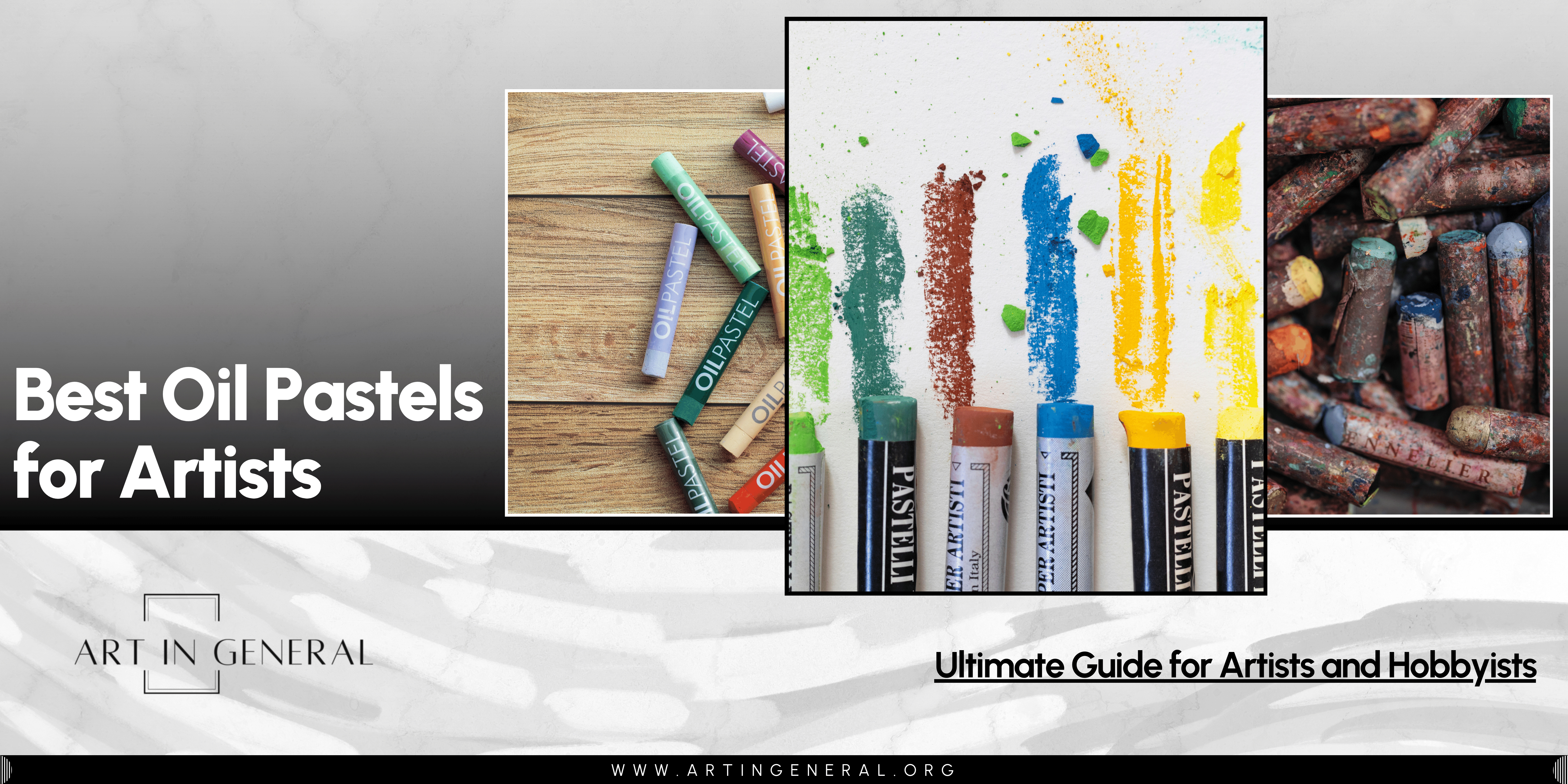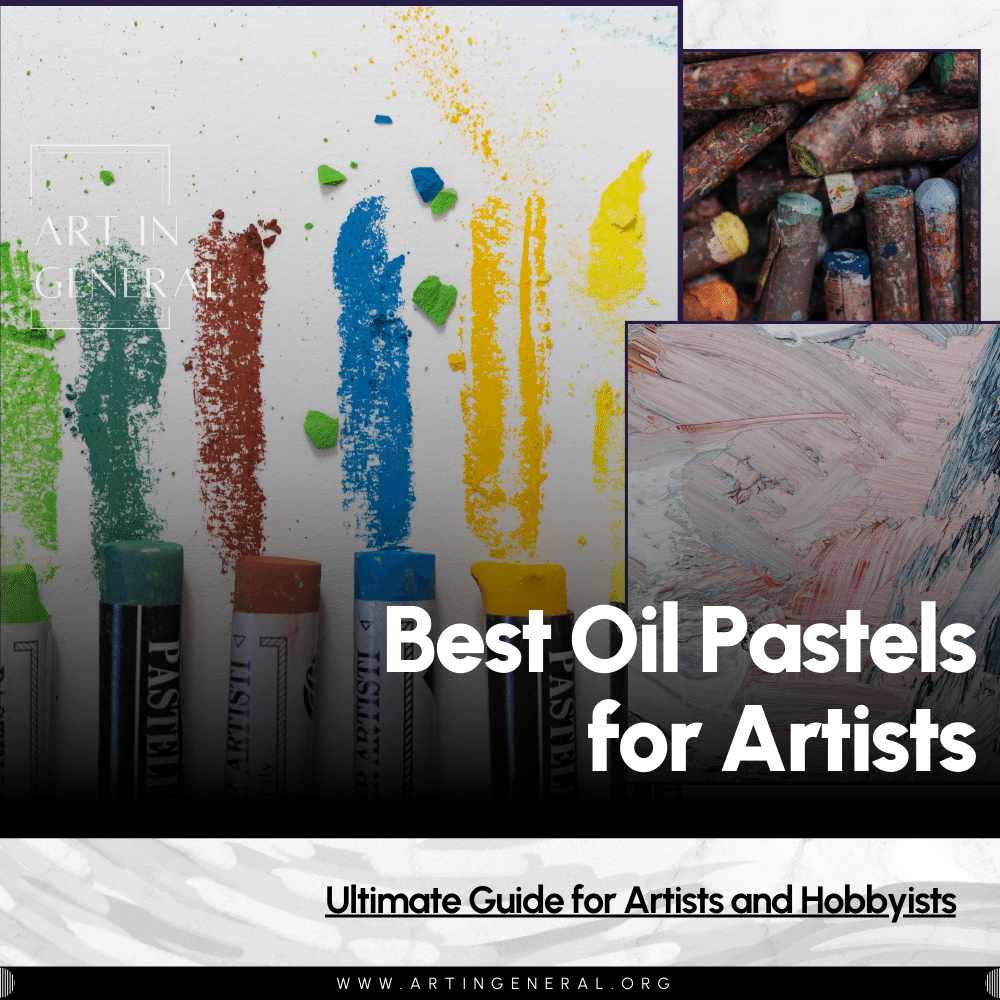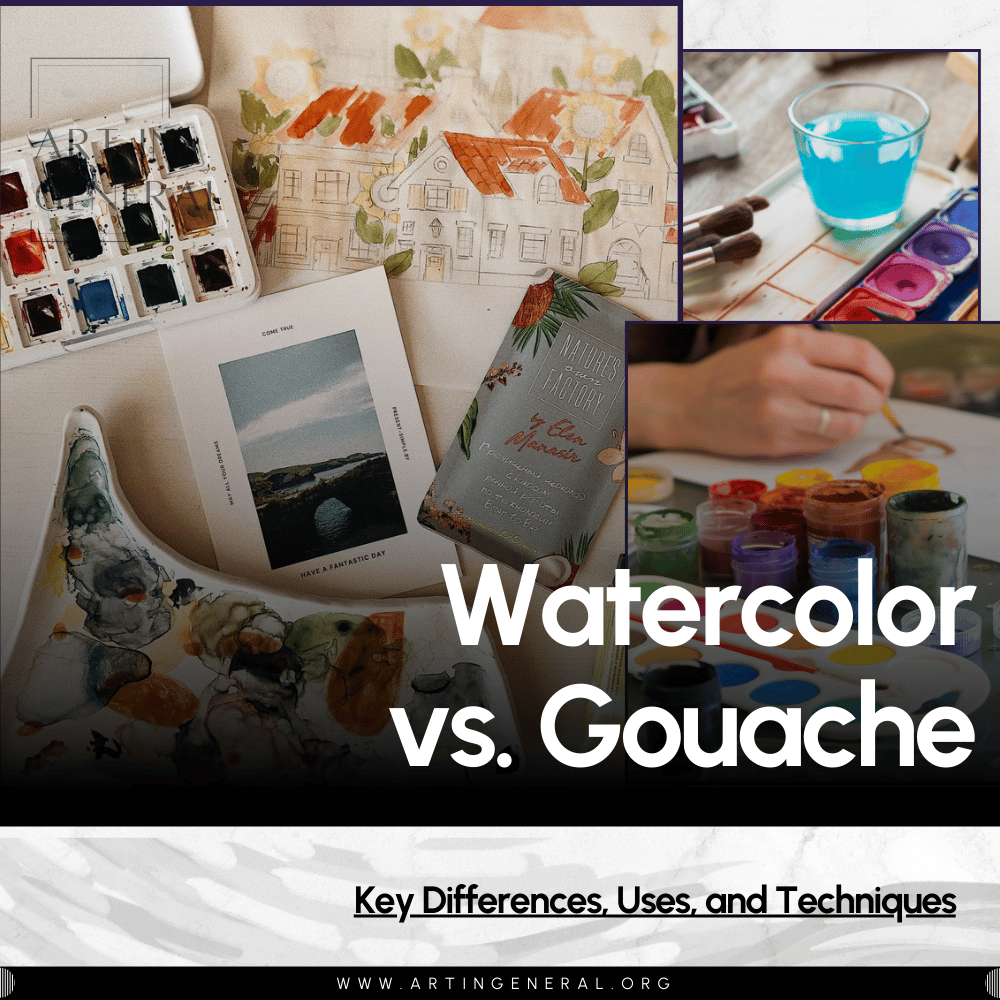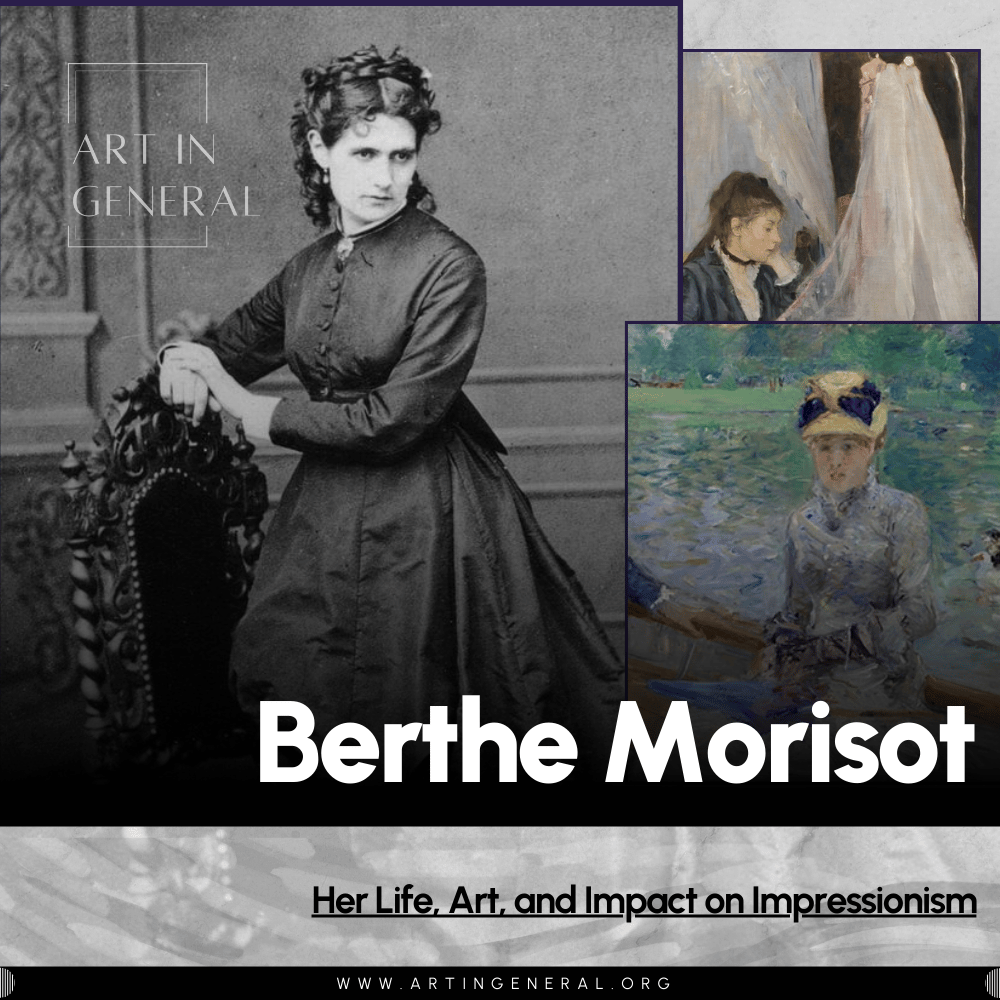
Oil pastels are a beloved medium for artists, with their vibrant colors and a buttery texture they can transform any canvas into a stunning masterpiece, however not all oil pastels are made the same, some are softer, some are firmer, some blend nicely while others make a great foundation for early layers.
In this guide, we’ll learn more about the factors that make oil pastels a great art medium, we’ll also cover options for all skill levels, from affordable sets for beginners to high-quality choices for experienced artists. No matter what kind of art you like to make, we’ll help you find the perfect oil pastels to bring your ideas to life. Join us as we explore the world of oil pastels and find the best ones for you. Let’s get started!
What Are Oil Pastels?
Oil Pastels are an art medium that is made with pigment mixed with a non-drying oil binder and then is shaped into small sticks, combining the convenience of a crayon with the vibrancy, softness and creaminess of oil paint.

Unlike soft pastels, which are made of dry pigment with a little bit of binder and crumble easily onto the paper leaving a dusty residue, oil pastels have a creamier consistency, which makes it easy to apply and blend, even with your fingers, especially the high quality ones.
Oil pastels can be used on different surfaces like paper, cardstock, canvas and wood, however since they don’t really dry they need to be handled with care as they might smudge or melt with the heat.
Key Features to Consider When Choosing Oil Pastels
Grade
Every art medium can be classified in different grades, according to the quality and type of artists they are made for. Popular art mediums like watercolors, acrylics and oil pastels can be classified in three grades: School Grade, Student Grade, and Professional Grade.

School grade oil pastels resemble more crayons sticks, they are very cheap, non-toxic and made to last longer and not break, however they don’t apply smoothly on paper and are better suited for children and use in classrooms.
Student Grade oil pastels are slightly more expensive than school grade oil pastels, and are made with hobbyists, art students and art enthusiasts in mind. They are very pigmented, much smoother and easier to apply and blend, however, not as creamy and soft as professional grade oil pastels. They are usually produced in a smaller color range, are made with more fillers than pigment and are not very lightfast.

Professional grade oil pastels are super creamy, easy to apply and blend, come in a much larger color range, and they are the best of the best, but are also much more expensive than student grade oil pastels. They are better suited for professional artists who have experience working with the medium and want their works to last for a long time.
Pigment Quality

Pigment quality is something every artist should consider before buying any material, however in oil pastels is especially important because the intensity and vibrancy of the colors directly impact how they behave and blend in the painting process. High quality pigments are more vivid, blend better, last longer and maintain their brightness over time, on the other side, low quality pigments are dull, chalky and when blending you mostly get muddy colors.
Look for oil pastels made with high quality pigments, that offer a decent color range and that have good reviews praising the color intensity of the pastels.
Texture and Consistency
When buying oil pastels you’ll come across differences in texture and consistency, especially when trying and comparing a few brands. While this depends on the price and quality of the pastels, it also has to do with the formulation. Most student grade oil pastels have a creamy consistency and are easy to apply, but some might leave a residue or be difficult to blend and mix together without a solvent. The texture and consistency depends mostly on the proportions of binder used in the making process, making some brands creamier and softer than others. While firmer oil pastels are great for beginners who have just started experimenting with oil pastels, soft oil pastels make a big difference in the amount of techniques and creative possibilities you have at your disposal.

Softer oil pastels are often labeled as soft or extra soft on online listings, while firmer oil pastels are labeled as simply oil pastels. Brands that stand out for their creaminess and soft texture are Sennelier, Mungyo Handmade Oil Pastels and Harbor Art Oil Pastels.
Lightfastness
Lightfastness is the resistance to fading when exposed to light that some pigments have. High quality pigments can remain as bright and vibrant as the first day for years, while low quality pigments tend to fade or dull with time. Highly lightfast oil pastels are made with high quality pigments and binders, which makes them more expensive than regular oil pastels, however this also ensures you can exhibit or sell your work without worrying of future discoloration or fading.

Price
Oil pastels prices can vary a lot, you’ll find sets that go for under $10 and sets that cost hundreds. This price difference is mostly due to the craftsmanship process, quality of pigment and binders and brand, however that doesn’t mean that you need the most expensive oil pastels from the start. If you’re just testing the waters with the medium, then going for a small set with 24 or 36 colors and a good color range won’t hurt your pockets as much. If you have more experience or a larger budget, going for a set with more than 48 colors would be the best, and if you’re already a professional, then going for a high quality set with a broad color range it’s probably the best choice.
Best Oil Pastel Sets in 2024
- Best Oil Pastels Overall — Harbor Art Oil Pastels
- Best Oil Pastels for Professionals — Sennelier Oil Pastels
- Best Budget Oil Pastels — Artecho Oil Pastels
- Best Oil Pastels for Students — Sakura Cray-Pas Expressionist
- Best Oil Pastels for Beginners — Mungyo Gallery Oil Pastels
1. Best Oil Pastels Overall — Harbor Art Oil Pastels

View Prices
About Harbor Art Oil Pastels
Harbor art is a new brand in the art supplies market, which has gained recognition for offering high-quality art supplies at accessible prices. Their Elite Artisan Oil Pastels are absolutely amazing, crafted for professional artists who look for excellent pigment quality and blendability. This set has a good color range, blends beautifully and is super easy to apply and use. Most artists appreciate the superior pigment load and the creamy consistency, which allows for seamless blending and rich, vivid colors. Despite being a relatively new brand, Harbor Art Supplies has quickly established a reputation for delivering professional-grade materials that don’t break the bank. Since the brand is quite new, the prices are super affordable despite the high quality they offer, so we suggest you snatch a set and try them for yourself.
What makes them great:
- Pigment Quality: High quality pigment.
- Our Score: 8/10
- Grade: Artist Grade.
- Our Score: 8/10
- Lightfastness: Good Lightfastness.
- Our Score: 8/10
- Texture and Consistency: Smooth and Buttery Texture.
- Our Score: 8/10
- Price: $11.49
- Our Score: 9/10
Pros
- Economical price
- Very high-quality
- Creamy and smooth application
Cons
- Limited color range
- Relatively new in the market
View Prices
Tips for Using Oil Pastels Effectively
- Start with light colors and gradually layer darker colors over them. This technique allows for better control and blending. Use tools like blending stumps, cotton swabs, or even your fingers to smooth out the colors and create gradients.
- Surface Choice: Choose the right surface for your project. Oil pastels work well on a variety of surfaces, including paper, canvas, and wood. Textured surfaces can hold more pigment and create interesting effects, while smooth surfaces allow for finer details.
- Experiment with different blending mediums such as baby oil or mineral spirits. These can help to achieve smoother blends and a more painterly effect. Use them sparingly to avoid oversaturation.
- Oil pastels can be messy. To keep your colors clean and prevent smudging, work on small sections at a time and protect the rest of your work with a piece of clean paper.
- Color Mixing: Unlike paints, you can’t mix oil pastels on a palette. Instead, mix colors directly on your working surface by layering and blending them. Practice creating different shades and tones by overlapping colors.
- Start with a light hand and build up to heavier applications. This approach allows for more control and makes it easier to correct mistakes or adjust colors.
- Apply a fixative spray to preserve your work and prevent smudging. Fixatives help set the pastels and add longevity to your artwork. Make sure to use a spray specifically designed for oil pastels to avoid unwanted texture changes.
View Prices
2. Best Oil Pastels for Professionals — Sennelier Oil Pastels
View Prices
About Sennelier Oil Pastels
Sennelier is one of the oldest art supplies brands in the market, being the original maker of oil pastel for artists and playing a key role in the development of this medium, they still maintain their reputation for producing high-quality, professional-grade oil pastels.
Their oil pastels quality is unmatched, they are made with the best pigments, each having an individual lightfastness rating, great blendability and color intensity, which is great for professional work.
They are the best of the best and are priced accordingly, and while the quality is great and the color range is very broad, they are still very expensive so we don’t recommend them for beginners or artists on a tight budget.
What makes them great:
- Pigment Quality: Very high quality pigment.
- Our Score: 9/10
- Grade: Professional Grade.
- Our Score: 9/10
- Lightfastness: Very High Lightfastness.
- Our Score: 9/10
- Texture and Consistency: Exceptionally smooth and velvety, They have a creamy consistency.
- Our Score: 9/10
- Price: $170.33
- Our Score: 7/10
Pros
- Intense color saturation
- Luxurious creamy texture
- Professional quality
Cons
- Very expensive
- Might smudge easily
- Needs careful handling
View Prices
3. Best Budget Oil Pastels — Artecho Oil Pastels

View Prices
About Artecho Oil Pastels
Artecho is a well-known budget brand in the art supplies world, offering the vibrancy and intensity of professional brands while keeping the price very budget friendly. This also applies for their oil pastels, which are very bright, easy to apply and super affordable, but are not the most lightfast or blendable out there. Definitely a great option for artists who want to try the medium but not overspend on a pricey set, students on a budget and perfect for children to use.
They do leave a bit of residue when working with them and their color range is limited to the 48 colors included in this set, and they are not sold separately except for the black and white that comes in a package of 10 (5 each).
What makes them great:
- Pigment Quality: Normal quality pigment.
- Our Score: 7/10
- Grade: Student Grade.
- Our Score: 7/10
- Lightfastness: Not specified.
- Our Score: – – /10
- Texture and Consistency: Soft texture.
- Our Score: 8/10
- Price: $8.49
- Our Score: 9/10
Pros
- Very affordable
- Decent color variety
- Easy to handle
Cons
- Lesser pigment quality
- Harder texture
- Less durability
View Prices
4. Best Oil Pastels for Students — Sakura Cray-Pas Expressionist

View Prices
About Sakura Cray-Pas Expressionist
Sakura Cray-Pas is the brand that started it all, the original oil pastel maker, however since their approach was directed towards children and education, they were not the default option for artists. Their Expressionist line came to change that, these oil pastels are a favorite among artists for their creamy texture and ease of use.
One of the outstanding qualities of Cray-Pas Expressionist is that the set also includes two color extender sticks, which helps with blending and mixing different colors. They deliver vibrant, bold colors that are comparable to higher-end brands for their smooth application and ability to blend well, plus they offer a good balance between quality and affordability, making them an excellent choice for beginners, students, and anyone looking to explore the medium without breaking the bank.
What makes them great:
- Pigment Quality: Normal quality pigment.
- Our Score: 8/10
- Grade: Artist Grade.
- Our Score: 8/10
- Lightfastness: Good Lightfastness.
- Our Score: 8/10
- Texture and Consistency: Exceptionally smooth and velvety, buttery, creamy consistency.
- Our Score: 8/10
- Price: $21.59
- Our Score: 8/10
Pros
- Student-friendly price
- Good color blendability
- Sturdy build quality
Cons
- Limited color intensity
- Can be waxy
- Less smooth texture
View Prices
5. Best Oil Pastels for Beginners — Mungyo Gallery Oil Pastels

View Prices
About Mungyo Gallery Oil Pastels
Mungyo Gallery Oil Pastels are a South Korean brand that makes Oil pastels known for their rich pigmentation and great blendability, they are the favorite of many artists and art enthusiasts due to their consistency, pigment quality, color range, and affordable price.
These pastels are on the firmer side, yet they still blend nicely making them easy to handle, perfect for beginners, intermediate, and advanced artists. The most outstanding feature is their color range, with 48 different colors that vary on hue, intensity and depth you’ll be able to make pretty much anything, be it still life studies, portraits, and beautiful landscapes.
These oil pastels are also very affordable for the quality they offer and the variety of colors they include, making them the best oil pastel set in the market at the moment.
What makes them great:
- Pigment Quality: High quality pigment.
- Our Score: 8/10
- Grade: Artist Grade.
- Our Score: 8/10
- Lightfastness: High Lightfastness.
- Our Score: 8/10
- Texture and Consistency: Creamy and crumbly.
- Our Score: 8/10
- Price: $20.89
- Our Score: 9/10
Pros
- Vibrant color output
- Smooth application
- Beginner-friendly
Cons
- Higher price point
- Soft texture breaks
Frequently Asked Questions (FAQs)
What are the best surfaces for using oil pastels?
Oil pastels work well on a variety of surfaces including paper, canvas, wood, and even glass. For best results, choose textured paper or a canvas with a bit of tooth to help the pastels adhere and create interesting effects. Some artists also use sanded paper for additional texture.
How do I blend oil pastels smoothly?
Blending oil pastels can be done using several methods. You can use your fingers, blending stumps, or cotton swabs to blend colors directly on the surface. Additionally, blending mediums like baby oil or mineral spirits can help achieve smoother transitions and a more painterly effect. Always use these mediums sparingly.
What is the sgraffito technique in oil pastels?
Sgraffito is a technique where you scratch through a layer of oil pastel to reveal the layer beneath. This can be done using tools like palette knives, toothpicks, or even old credit cards. It’s great for adding texture and intricate designs to your artwork.
How do I mix colors with oil pastels?
Unlike paints, you can’t mix oil pastels on a palette, especially if you’re a beginner. Instead, mix colors directly on your working surface by layering and blending them. Start with lighter colors and gradually add darker colors to achieve the desired shade and depth. Once you have enough experience, try using solvents like mineral spirits and baby oil to soften the oil pastels and use a palette knife to separately mix your own shades on a palette.
Are oil pastels suitable for beginners?
Yes, oil pastels are suitable for beginners due to their forgiving nature and ease of use. They don’t require a lot of preparation and can be used on various surfaces. Beginners can experiment with different techniques and find their unique style without a significant investment in materials.
How can I prevent my oil pastel artwork from smudging?
To prevent smudging, apply a fixative spray specifically designed for oil pastels. Work in sections and protect your work with a piece of clean paper. Another tip is to work from the top of the paper downwards to avoid resting your hand on completed sections.
How should I store my oil pastels to keep them in good condition?
Store your oil pastels in a cool, dry place away from direct sunlight. Keep them in their original box or a dedicated pastel storage box to protect them from dust and damage. Wipe the tips regularly to avoid color contamination.
Can I use oil pastels with other mediums?
Yes, oil pastels can be used with other mediums such as acrylics, watercolors, and inks. They are versatile and can be layered over dried paint or used in mixed media pieces to add texture and depth, but we don’t recommend to use other mediums on top of them.






Leave a Reply